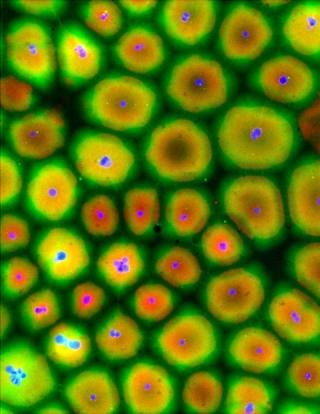Cytoplasm of scrambled frog eggs organizes into cell-like structures, Stanford study finds

After being scrambled, the cytoplasm of Xenopus frog eggs spontaneously reorganizes into cell-like compartments. Nuclei are blue; microtubules are green; the endoplasmic reticulum is red. Credit: Xianrui Cheng/Stanford Medicine
The cytoplasm of ruptured Xenopus frog eggs spontaneously reorganizes into cell-like compartments, according to a study by researchers at the Stanford University School of Medicine.
“We were gobsmacked,” said James Ferrell, MD, PhD, professor of chemical and systems biology and of biochemistry. “If you blend a computer, you'd end up with tiny bits of computer, and they wouldn't even be able to add two and two. But, lo and behold, the cytoplasm reorganizes.”
Remarkably, the self-assembled compartments retain the ability to undergo division and can form smaller compartments. Previous studies have shown that some subcellular structures, such as centrosomes and endoplasmic reticulum, can self-assemble outside cells from their purified components, demonstrating that these structures have some ability to self-organize. However, the new study provides the first example of self-organization at the scale and complexity of entire cells.
Ferrell is the senior author on the study, which will be published Nov. 1 in Science. The lead author is postdoctoral scholar Xianrui Cheng, PhD.
Compartments form spontaneously
The discovery relied on Cheng's observations. While studying a molecular process known as programmed cell death, he noticed the nuclei in a tube of cytoplasmic extract from frog eggs were behaving unexpectedly. After 30 minutes or so, the nuclei had organized so the distance between two nuclei was almost equal, Cheng said. When he imaged the cytoplasmic extract on microscope slides, he saw that it had formed distinct compartments that resembled a sheet of cells.
“If you take the cytoplasm of the frog egg — note that the cytoplasm has been homogenized, so whatever spatial structure that was there has been completely disrupted — and just let it sit at room temperature, it will reorganize itself and form small cell-like units. That's pretty amazing,” Cheng said. These cell-like compartments formed whether or not Xenopus sperm nuclei were added, suggesting that the behavior relied on something intrinsic to the egg.
To understand the mechanism underlying the phenomenon, the researchers tested whether compartment formation was affected by the addition of chemical inhibitors to cytoskeletal proteins, motor proteins and kinases, which activate other proteins. This approach revealed that ATP, the primary source of energy in the cell, and microtubules, cytoskeletal filaments that provide structural support, were required for compartments to form. Dynein, a type of motor protein, was also required for proper microtubule localization.
Self-organized compartments divide
These cell-like compartments not only looked like cells; they divided like them, too. The egg extract that the researchers used when they identified compartment formation contained a chemical that prevented the cells from entering the cell cycle. When this chemical was removed, and sperm nuclei were added, the egg extract formed compartments that divided into smaller compartments.
The researchers saw that these compartments could undergo over 25 rounds of division, indicating that the process was very robust. The division was also reductive, Cheng said, since the total amount of cytoplasm remained constant and was being divided into smaller and smaller compartments with each cycle. “You're taking the material from the egg, and it divides in a mode that's reminiscent of embryonic development,” he said. “Just like they're supposed to in a real egg.”
Future directions
All of these findings suggest that the Xenopus egg cytoplasm has the intrinsic ability to generate the basic spatial organization of the cell and even has some of its functions. An open question, however, is what role this phenomenon plays in the normal physiology of the egg. Another question is whether this ability to self-organize is peculiar to eggs or is shared by other types of cells.
The researchers also hope to further understand what's needed for self-organization to occur. “My favorite question right now,” Ferrell said, “is can we make a simple model that explains the basics of this organization process? Or do we have to do something extremely complicated, like account for every single thing that we know a microtubule can do?”
###
Ferrell is a member of Stanford Bio-X, the Stanford Cancer Institute and the Wu Tsai Neurosciences Institute at Stanford.
The research was supported by the National Institutes of Health (R01GM110564 and P50GM107615).
Stanford's departments of Chemical and Systems Biology and of Biochemistry also supported this work.
The Stanford University School of Medicine consistently ranks among the nation's top medical schools, integrating research, medical education, patient care and community service. For more news about the school, please visit http://med.
Print media contact: Rosanne Spector at (650) 725-5374 (manishma@stanford.edu)
Broadcast media contact: Margarita Gallardo at (650) 723-7897 (mjgallardo@stanford.edu)
Media Contact
All latest news from the category: Health and Medicine
This subject area encompasses research and studies in the field of human medicine.
Among the wide-ranging list of topics covered here are anesthesiology, anatomy, surgery, human genetics, hygiene and environmental medicine, internal medicine, neurology, pharmacology, physiology, urology and dental medicine.
Newest articles

NASA: Mystery of life’s handedness deepens
The mystery of why life uses molecules with specific orientations has deepened with a NASA-funded discovery that RNA — a key molecule thought to have potentially held the instructions for…

What are the effects of historic lithium mining on water quality?
Study reveals low levels of common contaminants but high levels of other elements in waters associated with an abandoned lithium mine. Lithium ore and mining waste from a historic lithium…

Quantum-inspired design boosts efficiency of heat-to-electricity conversion
Rice engineers take unconventional route to improving thermophotovoltaic systems. Researchers at Rice University have found a new way to improve a key element of thermophotovoltaic (TPV) systems, which convert heat…



